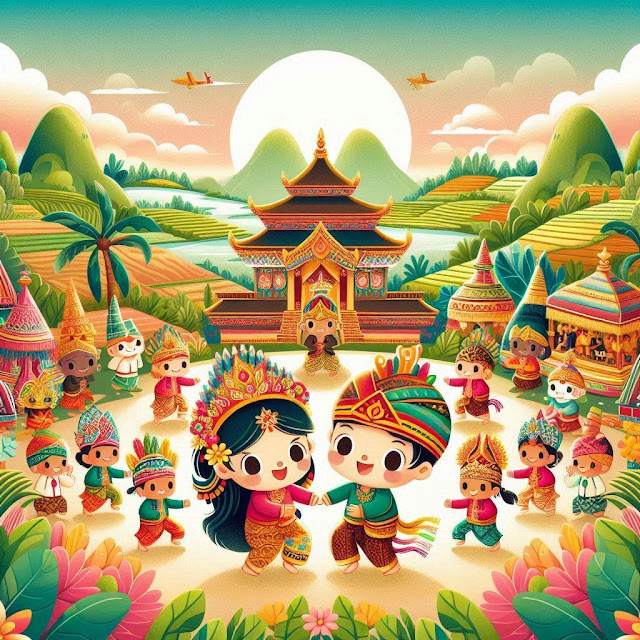Rhythmic Tales: Exploring the Rich Tapestry of Indonesian Folk Dances
Indonesian Folk Dances: Symbolizing Wealth and Diversity
Folk dances are typically passed down from generation to generation without a known choreographer. Indonesian folk dances are indeed known for their vibrant and emotional expressions, reflecting the country's rich diversity of ethnicities and cultures. These dances play an important role in preserving and showcasing Indonesia's cultural heritage.
Indonesia, with its diverse ethnic groups and regions, is home to a fascinating variety of folk dances. Each dance is unique in style, movements, costumes, and accompanying music. They often serve as vessels for telling stories, celebrating events, or offering traditional rituals. You can enjoy these beautiful performances during cultural festivals, religious ceremonies, social gatherings, and other community events.
A number of Indonesian folk dances have stolen the world's attention. There are classical Javanese dances such as Bedhaya, which is very graceful, and Jaranan, which is full of energy. Bali is famous for its iconic Legong dance and the amazing Barong dance. You can also find traditional Minangkabau dance from West Sumatra, Tor-Tor dance from North Sumatra, and the stunning Saman dance from Aceh.
However, Indonesian folk dance is not just entertainment or artistic expression. They play an important role in strengthening community ties, preserving cultural identity, and passing on traditional values and stories. All who witness these dances continue to appreciate and celebrate them as a priceless piece of Indonesian culture.
More than just movements and melodies, Indonesian dance reflects the richness and diversity of Indonesian ethnicity and culture. With more than 700 ethnic groups in existence, their cultural influence can be seen in every dance movement. From the cultural roots of the Austronesian people to touches of Melanesian culture, as well as influences from neighboring countries and the era of colonialization, every ethnic group in Indonesia brings its own unique dance. Indonesia is home to more than 3,000 indigenous dances.
Indonesian dances don't just speak about the present; they are also a window to the past. The ancient traditions of dance and drama are passionately preserved in various dance studios and art schools recognized by the court or the government. This is a great effort to keep traditional stories alive and meaningful.
In an effort to understand dance art more deeply, it can be classified into various categories, including in terms of history and tradition. Indonesian dance reflects the long journey and rich diversity of Indonesian culture. Let's fall in love with the beauty and meaning in every movement and enjoy exploring the magical world of Indonesian folk dance.
The History of Indonesian Dance: From Ancient Rituals to the Islamic Era
Tribes in Indonesia had created their own dance forms before being influenced by outside cultures. This can be seen in various tribes that live simply in the interior, such as the Batak tribe in Sumatra, the Dayak tribe in Kalimantan, and the Toraja tribe in Sulawesi. Anthropologists believe that dance in Indonesia originated from ritual movements and religious ceremonies. This dance is used in various rituals, from war dances to dances to summon rain.
As Hinduism and Buddhism spread in Indonesia, dances depicting epic stories such as the Ramayana and Mahabharata became popular. These kinds of dances, often called "Sendratari," are an important part of Indonesian performing arts. This dance is often performed in temples such as Prambanan in Java and various temples in Bali.
When Islam began to enter Indonesia, the art of dance continued to develop. The dancers incorporate Islamic elements into their dances, substituting stories that are more in line with Islamic teachings and adapting their costumes. This resulted in dances such as the Malay Zapin and Acehnese Saman Dance, which combine Arabic and Persian dance styles with local elements.
The history of Indonesian dance is a long journey that reflects the cultural and religious diversity of the archipelago. From ancient ritual dances to Islamic-era dances, the art of dance continues to develop and depict Indonesia's rich identity. For the younger generation, exploring the history of this dance is an exciting way to understand our incredible cultural heritage.
Indonesian Folk Dances: Inspiring and Preserving
Indonesia has an invaluable cultural treasure in its folk dances. In every dance movement, there is a story, traditional treasures, and sounds that celebrate diversity and unity. These dances are a window into various cultures and pasts that depict the richness of Indonesia.
Folk dance is more than just entertainment. They are the key to understanding deep cultural roots, strengthening community ties, and passing on cherished values from generation to generation. Dance is a celebration of identity, ancestral heritage, and stories that still live in movement and melody.
For young explorers, aspiring dancers, and culture lovers, let's embrace Indonesian dance. Learn the movements that connect us to the past and discover the beauty in each choreography. In every dance step, we can find stories from all over the archipelago, from Sabang to Merauke.
Let's celebrate the richness of Indonesian culture together. Let's make dance a means of sharing, learning, and celebrating diversity. In this way, we honor the generations that came before us and pave the way for generations to come. Indonesian dance is a heritage that we should preserve.
A journey into the world of Indonesian folk dance awaits. Let's celebrate traditions, unite stories, and embrace the Indonesian flavor.
List of Indonesian Folk Dances
from North Sumatra
From East Java
Traditional dance of people in Gayo Aceh
From West Sulawesi
from West Sumatra
from East Java
From East Java
From Bali
Other Links

.jpeg)
.jpeg)

.jpeg)

















No comments:
Post a Comment